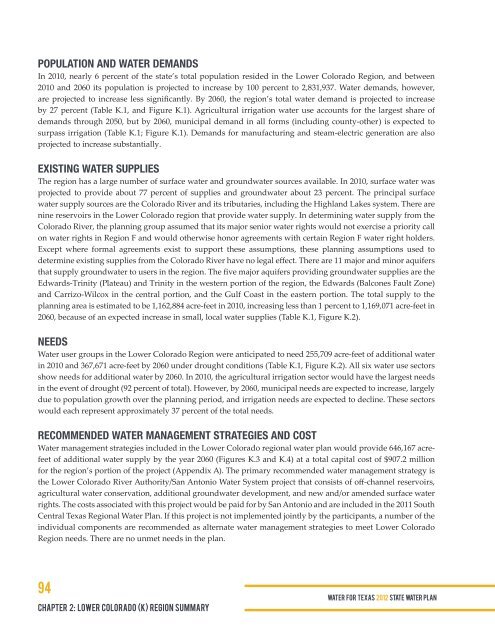Chapter 2 Regional Summaries - Texas Water Development Board
Chapter 2 Regional Summaries - Texas Water Development Board
Chapter 2 Regional Summaries - Texas Water Development Board
You also want an ePaper? Increase the reach of your titles
YUMPU automatically turns print PDFs into web optimized ePapers that Google loves.
POPULATION AND WATER DEMANDS<br />
In 2010, nearly 6 percent of the state’s total population resided in the Lower Colorado Region, and between<br />
2010 and 2060 its population is projected to increase by 100 percent to 2,831,937. <strong>Water</strong> demands, however,<br />
are projected to increase less significantly. By 2060, the region’s total water demand is projected to increase<br />
by 27 percent (Table K.1, and Figure K.1). Agricultural irrigation water use accounts for the largest share of<br />
demands through 2050, but by 2060, municipal demand in all forms (including county-other) is expected to<br />
surpass irrigation (Table K.1; Figure K.1). Demands for manufacturing and steam-electric generation are also<br />
projected to increase substantially.<br />
EXISTING WATER SUPPLIES<br />
The region has a large number of surface water and groundwater sources available. In 2010, surface water was<br />
projected to provide about 77 percent of supplies and groundwater about 23 percent. The principal surface<br />
water supply sources are the Colorado River and its tributaries, including the Highland Lakes system. There are<br />
nine reservoirs in the Lower Colorado region that provide water supply. In determining water supply from the<br />
Colorado River, the planning group assumed that its major senior water rights would not exercise a priority call<br />
on water rights in Region F and would otherwise honor agreements with certain Region F water right holders.<br />
Except where formal agreements exist to support these assumptions, these planning assumptions used to<br />
determine existing supplies from the Colorado River have no legal effect. There are 11 major and minor aquifers<br />
that supply groundwater to users in the region. The five major aquifers providing groundwater supplies are the<br />
Edwards-Trinity (Plateau) and Trinity in the western portion of the region, the Edwards (Balcones Fault Zone)<br />
and Carrizo-Wilcox in the central portion, and the Gulf Coast in the eastern portion. The total supply to the<br />
planning area is estimated to be 1,162,884 acre-feet in 2010, increasing less than 1 percent to 1,169,071 acre-feet in<br />
2060, because of an expected increase in small, local water supplies (Table K.1, Figure K.2).<br />
NEEDS<br />
<strong>Water</strong> user groups in the Lower Colorado Region were anticipated to need 255,709 acre-feet of additional water<br />
in 2010 and 367,671 acre-feet by 2060 under drought conditions (Table K.1, Figure K.2). All six water use sectors<br />
show needs for additional water by 2060. In 2010, the agricultural irrigation sector would have the largest needs<br />
in the event of drought (92 percent of total). However, by 2060, municipal needs are expected to increase, largely<br />
due to population growth over the planning period, and irrigation needs are expected to decline. These sectors<br />
would each represent approximately 37 percent of the total needs.<br />
RECOMMENDED WATER MANAGEMENT STRATEGIES AND COST<br />
<strong>Water</strong> management strategies included in the Lower Colorado regional water plan would provide 646,167 acrefeet<br />
of additional water supply by the year 2060 (Figures K.3 and K.4) at a total capital cost of $907.2 million<br />
for the region’s portion of the project (Appendix A). The primary recommended water management strategy is<br />
the Lower Colorado River Authority/San Antonio <strong>Water</strong> System project that consists of off-channel reservoirs,<br />
agricultural water conservation, additional groundwater development, and new and/or amended surface water<br />
rights. The costs associated with this project would be paid for by San Antonio and are included in the 2011 South<br />
Central <strong>Texas</strong> <strong>Regional</strong> <strong>Water</strong> Plan. If this project is not implemented jointly by the participants, a number of the<br />
individual components are recommended as alternate water management strategies to meet Lower Colorado<br />
Region needs. There are no unmet needs in the plan.<br />
94<br />
<strong>Chapter</strong> 2: lower colorado (k) region summary<br />
WAT E R FOR TEXAS 2012 STATE WATER PLAN
















